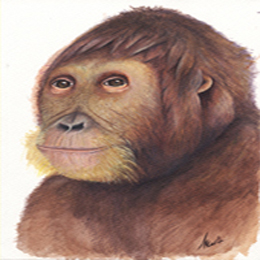ICP-UAB researchers describe a new hominid

The study based on this Middle Miocene genus (11.9 Ma, or million years before present) is reported in a publication by Moyà-Solà and co-authors in the next issue of the renowned US scientific journal "Proceedings of the National Academy of Sciences" (PNAS). The team of researchers involved in this publication, coordinated by Salvador Moyà-Solà, director of the Catalan Institute of Palaeontology (ICP), sponsored by Universitat Autònoma de Barcelona and the Catalan Government, included: David M. Alba, ICP collaborator; Sergio Almécija, predoctoral researcher at ICP; Isaac Casanovas, postdoctoral researcher at ICP; Meike Köhler, researcher and head of a research group at ICP; Soledad De Esteban, postdoctoral researcher at ICP; Josep M. Robles, ICP collaborator; Jordi Galindo, ICP curator; and Josep Fortuny, predoctoral researcher at ICP.
The new hominid has been given the scientific name of Anoiapithecus brevirostris, in reference to the region where the town of Els Hostalets is situated (l'Anoia) and also to the fact that the new taxon has a very modern facial morphology, characterised by a very reduced facial prognathism, i.e. a very short face. Colloquially we have named it Lluc since it is a male individual. This name stems from the fact that Lluc in Latin means "the one who illuminates", and certainly, the information provided by this new fossil is so important that it permits to solve some key questions on the origin of the Hominidae family.
The new genus and species, Anoiapithecus brevirostris, has been described on the basis of a partial cranium that preserves most of the face and the associated mandible. This cranium was recovered during the works of paleontological control that are customarily carried out at ACM, due to the fossiliferous richness of the area of Els Hostalets de Pierola. The process of preparation was long-lasting and complicated, due to the fragility of the remains, but once the material was fit for analysis, the surprise was enormous. The specimen (IPS43000) combined a set of features that until now had not been found in the fossil record.
Anoiapithecus displays a very modern facial morphology, with such a reduced muzzle prognathism that, within the family Hominidae, we can only find comparable values within the genus Homo, whereas the remaining great apes are notably more prognathic. This extraordinary fact does not indicate that Anoiapithecus has any relationship with Homo, but it might be a case of convergence. The evolutionary meaning of this discovery is surely a different one, but this does not make it any less interesting.
The second surprise provided by Lluc is that it enabled to solve two key questions regarding the origin of our family: what group it is derived from, and which is the geographic area where the Hominidae family originated. The detailed morphological study of the cranial remains of Lluc showed that, together with the modern anatomical features characterising the Hominidae family (among others, nasal aperture wide at the base, high zygomatic root, deep palate), and which permit to consider it a member of this family, it displays a set of primitive features, such as thick dental enamel, teeth with globulous cusps, very robust mandible and very procumbent premaxilla, which are primitive features characteristic of a group of primitive hominoids from the African Middle Miocene, known as afropithecids.
And this is the key of the issue: the discovery enables to identify two possible candidates as the ancestral form of our family (Kenyapithecus and Griphopithecus). Taking into account that these two genera cannot yet be considered members of the Hominidae family because they lack its basic diagnostic features, it is obvious that the origin of our family is a phenomenon that took place in the Mediterranean region during the time span comprised between their arrival from Africa around 15 Ma and 13 Ma, the period which the first members of our family in Els Hostalets are from. As such, the team of Salvador Moyà and his collaborators consider that hominids might have originally radiated in Eurasia from kenyapithecine ancestors of African origin.
The project at Els Hostalets de Pierola continues and, surely, more fossil remains will be found in the future (at ACM or elsewhere in the world) which will provide new key information that will enable to test this new hypothesis.
References
A unique Middle Miocene European hominoid and the origins of the great ape and human clade. Moyà-Solà, S. et al. Proceedings of the National Academy of Sciences, 22 (vol.106), March 2009.


